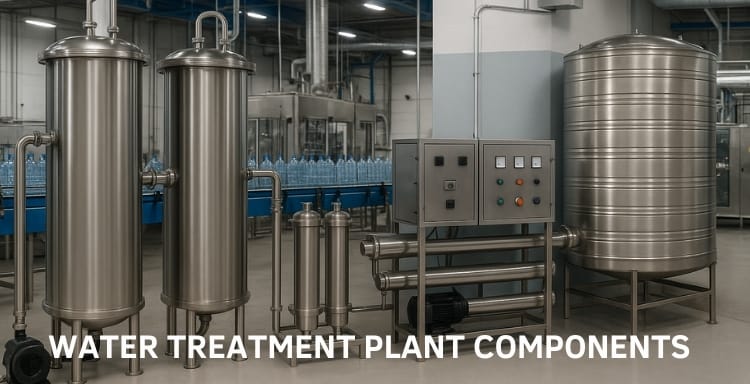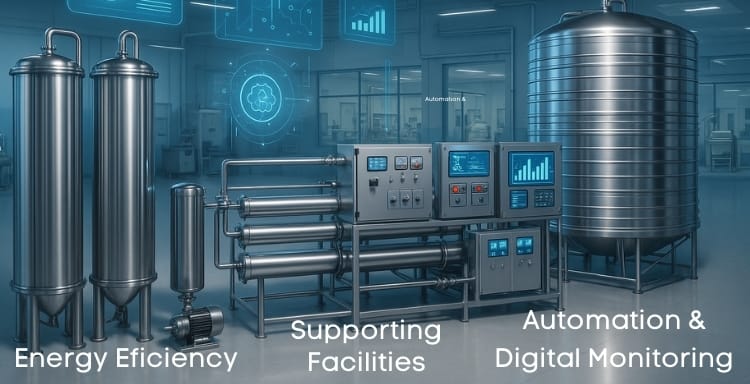
Table of Contents
Key Components of any Water Treatment Plant
October 17, 2022
In today’s world, access to clean and safe drinking water is one of the most pressing challenges. According to the World Health Organization (WHO), nearly 2 billion people worldwide rely on contaminated water sources, and unsafe drinking water causes an estimated 485,000 deaths annually due to diarrheal diseases. With rapid urbanization and industrial growth, the demand for purified water is rising exponentially.
Water Treatment Plants (WTPs) play a vital role in ensuring safe water for households, industries, and communities. These plants combine advanced purification technologies and multi-stage processes to eliminate suspended solids, harmful microorganisms, toxic chemicals, and undesirable tastes or odors. From raw water intake to the final bottling or distribution, each stage of a water treatment plant is critical in meeting global water quality standards such as WHO, BIS (Bureau of Indian Standards), and US EPA guidelines.
This article explores the key components and processes of a water treatment plant, highlighting both conventional and advanced treatment methods that ensure a reliable supply of safe, potable water.
In a water treatment plant, water is sourced naturally from mountain water or spring water, because this water comprises minerals that are fruitful for consumption. However, in the mineral water plant – we process and add minerals to the water for the enhancements. Minerals like calcium, magnesium, potassium, and sodium are added.

Processes differ from one plant to another. Usually, water treatment systems utilize a series of steps that make water safe to drink for communities. However, the technical aspects of a mineral water plant involve Coagulation, Reverse Osmosis, Chlorination of Water, Sand Filtration, Carbon Filtration & lastly, Packaging and Bottling.
Raw Water Intake: The very first stage of a water treatment plant is drawing raw water from natural sources such as rivers, lakes, or reservoirs. Intake wells and pumps are used to safely transport this raw water into the treatment facility, ensuring a continuous and reliable supply for further purification steps.
Screening: At the intake point, large debris like leaves, sticks, and stones are removed using bar screens or mesh screens. This prevents damage to downstream equipment and ensures smoother treatment processes.
Aeration: Air is introduced into the water to remove dissolved gases like carbon dioxide, hydrogen sulfide, and volatile organic compounds. This step also improves oxygen levels, which helps in controlling taste and odor issues.
Coagulation: Coagulation is the foremost step in the process, where we add Alum chemicals into the water. Alum removes impurities and evokes positive charges that blend into the negatives in the water to form large molecules that can be removed easily. The water then settles for an hour.
Flocculation: After coagulation, the water is gently mixed to encourage the formation of larger, heavier flocs. These flocs settle more easily during sedimentation, making the process of removing impurities more effective.
Sedimentation (Clarification): In this stage, the heavier flocs formed during coagulation and flocculation settle at the bottom of the clarifier or sedimentation tank. This step significantly reduces suspended solids and prepares the water for finer filtration.
RO Process: The RO Process removes the impurities from the water, making it safe to use.
Water Chlorination: The chlorination process kills all the microorganisms and bacteria inside the water by bubbling chlorine gas into the chlorination tank.

UV Disinfection: Along with chlorination, some treatment plants also use ultraviolet (UV) light to kill or inactivate harmful microorganisms. UV disinfection is a chemical-free method that ensures additional safety against bacteria and viruses.
Advanced Membrane Technologies: In addition to RO, ultrafiltration (UF) and nanofiltration (NF) membranes are increasingly being used for specialized applications. These membranes provide an added layer of purification by removing viruses, fine colloids, and specific contaminants, making them ideal for municipal water treatment and industries requiring ultra-pure water.
Sand filtration: The water is then passed through sand filters to remove undissolved impurities.
Filtration by sand: Sand filtration helps terminate the extra impurities from the un-dissolved water.
Read Our Article: How To Start Mineral Water Plant Business In India?
Carbon filtration de-chlorination : Once the sand filtration is completed, the water is passed through the Carbon de-chlorination to remove its color and odor. The process also takes place using carbon filters.
pH Adjustment: Chemicals such as lime or soda ash may be added to stabilize the pH level of treated water. This step prevents corrosion in pipelines and ensures the water remains safe and palatable for consumption.
Final Bottling & Packaging : Once the process is completed, the final step begins with packaging and bottling with the machines’ assistance.
Storage & Distribution: Once the water has been treated and disinfected, it is stored in a clear water reservoir or storage tank. From here, pumping systems distribute the treated water through pipelines, making it accessible to end consumers.

Read Our Article: How To Start Mineral Water Plant Business In India?
Energy Efficiency in Water Treatment: Modern treatment plants are designed to minimize energy consumption. Techniques such as gravity-fed systems, energy recovery from high-pressure RO, and solar-powered pumping solutions are being adopted to make water purification more sustainable and cost-effective.
Supporting Facilities: Modern water treatment plants also include auxiliary systems for efficiency and quality assurance. These may include sludge handling units for managing settled solids, instrumentation and SCADA systems for real-time monitoring, and on-site laboratories for continuous water quality testing.
Automation & Digital Monitoring: Smart water treatment plants are now equipped with Supervisory Control and Data Acquisition (SCADA) systems, IoT-enabled sensors, and AI-driven monitoring tools. These technologies allow real-time analysis of water quality parameters, reduce manual errors, and ensure compliance with regulatory standards.

Conclusion:
Water is not just a basic necessity but the foundation of healthy living and sustainable development. A well-designed water treatment plant integrates multiple purification stages—right from intake and screening to advanced filtration, disinfection, and safe distribution. With global water demand expected to rise by 55% by 2050 (UNESCO), the role of modern WTPs will become even more crucial.
By adopting advanced technologies like RO, UV, ultrafiltration, and automation, treatment plants can deliver consistent, high-quality water while optimizing energy use and reducing environmental impact. Whether for domestic supply, commercial establishments, or industrial operations, the effectiveness of a water treatment plant directly reflects in public health, safety, and overall quality of life.
DTPPL is the leading and well-established mineral water plant, Water Bottle Filling Machine facilitator in Gujarat. We follow all the recommended steps to make drinking water safe to drink. We are a team of certified staff working hard every day to meet the demands of our customers and benefit them with quality outcomes. Our main motto is to help you with the most exceptional service. Choose DTPPL if you prioritize quality over quantity.
About Author

Director – Global Marketing and Sales
Mr. Bhavesh from Dharmanandan Techno Projects Pvt. Ltd. has played a pivotal role in elevating the DTPPL brand to the global stage, leveraging his exceptional expertise in marketing and communications. He is committed to helping clients achieve significant growth while strengthening their own brands. Dharmanandan Techno Projects Pvt. Ltd. is a leading manufacturer and supplier of water purification systems and turnkey solutions for mineral water plants. With years of experience in designing and delivering high-quality water treatment solutions, the company provides end-to-end services, including system design, installation, maintenance, and ongoing support. Specializing in scalable and customizable water plants, DTPPL has successfully served industries worldwide, ensuring clean and safe drinking water across diverse applications.




